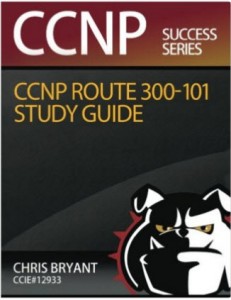CCNP ROUTE And TSHOOT Course: Route Redistribution
To celebrate the launch of my new website, I’ve posted a massive CCNP ROUTE and TSHOOT tutorial and lab series dealing with one of the toughest topics on either exam — route redistribution. This is part 1, where we’ll take a look at route redistribution fundamentals and run a few simple labs to illustrate a few concepts you must know for the CCNP exams.
Route redistribution is simply the process of taking routes from one source and placing them into a separate routing process. The route source doesn’t have to be a dynamic routing protocol – we can redistribute directly connected networks and static routes as well.
That’s all there is to it! Class dismissed!
Hey! Get back here!
Okay, “simply” may be a tad misleading. The basic configurations involved with route redistribution are simple, but there are two particular things to watch out for.
First: The more route redistribution you have, the greater the chance of routing loops. That’s particularly true when you’re redistributing between networks with multiple entrance and exit points, as in the following illustration. If we allowed R4 to advertise those same routes back to R2, we’d greatly increase the chance of a routing loop.

Second: Watch for route redistribution details regarding seed metrics, a default value given to a route as it’s redistributed. Some protocols require the network admins to set the seed metric. Another protocol has that metric built into the redistribution process. As you’ll see, these rules are not complex, but they’re vital to successful route redistribution. We’ll see several examples of this during our lab work.
Before we get involved with redistribution between different protocols, let’s have a look at a simple redistribution scenario or two using only one protocol. We’ll start with this EIGRP network, which is running two separate autonomous systems.
The question: Will the router in AS 12 automatically see the route from AS 13 (3.3.3.0 /24), and will the router in AS 13 automatically see the route from AS 12 (2.2.2.0 /24)?
The answer: Let’s find out!

I trust we have those adjacencies, but as always, we’ll trust and verify with show ip eigrp neighbor. You likely had only one AS in your CCNA lab work, so I want to point out that adjacencies are divided by AS in this output when you have more than one autonomous system.
R1#show ip eigrp neigh IP-EIGRP neighbors for process 13 H Address Interface Hold Uptime SRTT RTO Q Seq (sec) (ms) Cnt Num 0 10.1.1.3 Fa0/0 11 00:15:13 1 300 0 3 IP-EIGRP neighbors for process 12 H Address Interface Hold Uptime SRTT RTO Q Seq (sec) (ms) Cnt Num 0 172.12.123.2 Se1/0 152 00:14:37 277 1662 0 3
R1 sees the loopbacks its neighbors are advertising…
R1#show ip route eigrp 2.0.0.0/24 is subnetted, 1 subnets D 2.2.2.0 [90/20640000] via 172.12.123.2, 00:14:42, Serial1/0 3.0.0.0/24 is subnetted, 1 subnets D 3.3.3.0 [90/156160] via 10.1.1.3, 00:14:21, FastEthernet0/0
… but there’s not an EIGRP route to be found on R2 or R3. That’s because there is no automatic redistribution between EIGRP ASes.
R2#show ip route eigrp (nothing to show, drops back to prompt) R2#
R3#show ip route eigrp (nothing to show again, drops back to prompt again) R3#
There’s also no auto-redistribution between multiple OSPF processes on the same router, as we’ll see in this quick lab.

R1 has the adjacencies and the routes, but neither R2 nor R3 sees the other router’s loopback for the same reason we ran into in the EIGRP lab — there is no automatic route redistribution between multiple OSPF domains running on the same router.
R1#show ip ospf neighbor Neighbor ID Pri State Dead Time Address Interface 3.3.3.3 1 FULL/BDR 00:00:33 10.1.1.3 FastEthernet0/0 2.2.2.2 0 FULL/DROTHER 00:01:39 172.12.123.2 Serial1/0
It’s up to you and me as the network admins to make route redistribution happen, and we’ll start making that happen in the following RIP and OSPF route redistribution lab.
Thanks for coming by!
Chris B.
_________________________________________________________
Chris Bryant’s CCNP ROUTE Study Guide on Amazon
Cisco Press CCNP ROUTE Study Guide on Amazon
Check ’em both out!
__________________________________________





